It is not enough to start writing and publish any text on your website to achieve online visibility. The truth is that you need to create optimized content with various SEO techniques to win the favor of Google or other search engines. This type of content will allow your target audience to find you easily, generate more traffic and increase the chances of conversion.
Find out today what I mean by SEO-friendly content, the benefits it has for your site, and some tips on how to create it. Don’t miss it!
- SEO-Friendly Content – Meaning & Purpose
- How To Write SEO-Friendly Content – 10 Easy Tips
- 1. Do Keyword Research
- 2. Structure Your Content – Keep In Mind Search Engines Metrics
- 3. Keep Your URLs Clean and Friendly
- 4. Meta Descriptions: Help Users Know Your Site!
- 5. Optimize Images – Including Titles and ALT Attribute
- 6. Add Links – Internal Links & External Links
- 7. Ideal Content Length: How Long Your Text Needs to Be
- 8. Keep Your Content Updated – Renew Old Blog Posts
- 9. Social Media Buttons – Go Viral!
- 10. Schema Markup: Highlight the Relevant Content
- Final Thoughts
- Frequently Asked Questions
SEO-Friendly Content – Meaning & Purpose
SEO-friendly content is written and designed to help search engines find, understand, and easily rank your site.
How does it do that? First, it helps Google to better understand the topic of your website and present it as a suitable option to users.
SEO-friendly content planning and writing is much more than just stuffing your text with keywords, a mistake that, unfortunately, many small business owners or beginner digital marketers make. No, an SEO strategy goes much further!
The primary purpose is to create valuable content designed for users’ search intent that can solve the doubts or questions that originated their query. The information you publish must answer what they want to find on the search engine results page!
Yes, part of the optimized content is doing keyword research. You must include key terms or phrases that will allow you to appear on the first search results page and drive traffic to your site. Get to know the best keyword research tools.
Choose the right words!
How To Write SEO-Friendly Content – 10 Easy Tips
1. Do Keyword Research
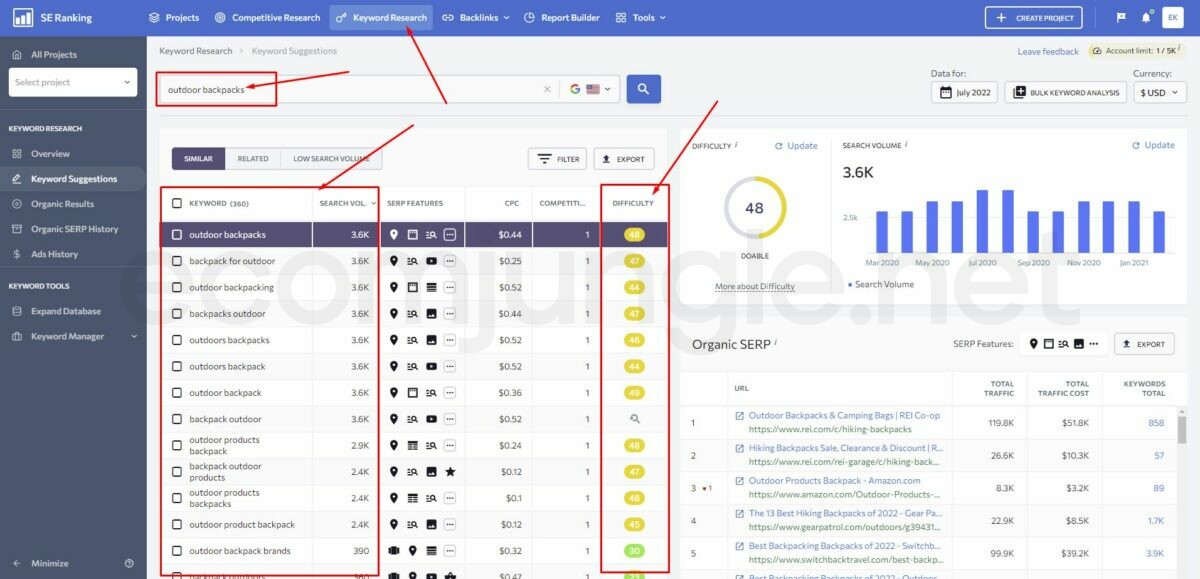
What is keyword research? Well, find the terms expressed in phrases that people use to search for information related to the content you need to position. Then, of course, you need to use specialized SEO tools to optimize your keyword map to attract visits and leads.
What you need to look at when doing keyword research:
- Search Volume: represents the number of monthly searches for a term in the search engine.
- Determine Search Intent: shows what the user wants to find on the web when using search engines. More than a keyword, the search brings the desire to solve a need.
- Keyword Difficulty: find out what terms are easier to rank on the search results page. Which ones are at the top to know how to write SEO-friendly content.
- Select Long-Tail Keywords Over Short-Tail: these are terms generally with low traffic potential but low keyword difficulty and therefore easier to position, especially for online business. Find out how to do your eCommerce keyword research.
Ready, do you have your target keyword? Well, make the best use of it!
Something that many creators miss includes a target keyword in the names and ALT tags of your images.
Please don’t abuse it. Instead, when SEO writing, use the density formula to know how many SEO keywords per page you need to focus on and avoid keyword stuffing.
Create content that motivates reading!
2. Structure Your Content – Keep In Mind Search Engines Metrics
Although sometimes it is not considered, the structure is fundamental in what is SEO-friendly content. Therefore, as you include relevant factors for search engines metrics here, I mention them one by one:
- Title Tags – H1, H2, and H3: Your content must contain titles and subtitles that help the user quickly understand the blog posts, articles, descriptions, or other types of content.
Remember that users flick through and then read!
So when you include a title tag helps Google to understand your content structure, how the title or subtitles relate to your topic, and if it matches the right format search intent
- Target Keyword: Define your primary keyword and add it in the title and first paragraph. You can use synonyms to get related keywords because if you use the same term too many times, Google may think you are “over optimizing” and will punish you.
- Short Paragraphs: These should not contain more than 25 words, and you should separate them by block to make them more accessible for the user to read. Readers usually get overwhelmed or scared away when a text is too long. If you want them to stay on your site and no mere “scanning,” this is a crucial point.
- Content-Length: Ideally, your page or blog post should be over 500 words to get more visibility. In the past, creators used short texts because they thought users read them easily.
However, a Semrush study shows that blog posts with more than 3000 words get four times more traffic.
If you make long content, remember to add an index.
- Highlight Main Ideas: Bold the basic ideas of the most outstanding ones so that the user will recognize them, and it will be easier to understand the objective of the content.
- Create Lists: This way, your readers will be able to read the content more easily and organize the ideas or essential points of your post.
- Metadata: The meta title, meta description, and ALT are essential for users to understand before opening what the content is about and let them know that your post is the one they should open.
Remember that readers expect a fluid and coherent story, so avoid forced, technical phrases.
3. Keep Your URLs Clean and Friendly
A Friendly URL is nothing more than a clear and concise link containing keywords referring to the content of a given subpage.
Its elements, organized logically, have a positive impact on the visibility and ranking of a specific website, as they help users and robots navigate the page effortlessly.
Backlinko research found that short URLs rank above long URLs. For example, the one in the first position of search results is, on average, 9.2 characters shorter than the one that ranks in the tenth position
Here is what a user-friendly and readable URL should look like:
https://ecomstrive.com/keyword-research-tools
On the other hand, this is the opposite model:
http://no-address.com/uk/467unhuoggnd912
Three main advantages of creating URL readable:
- Increase the visibility of your landing pages, blog posts, and eCommerce sites
- Generate more traffic,
- Improve the user experience; who knows what they will find on your page when they click on it.
4. Meta Descriptions: Help Users Know Your Site!
Meta descriptions are HTML tags used to briefly describe the content of web pages in the form of a sequence. In the SERP results of the search engine, you will see the meta description just below the page title.
It is one of the best ways of SEO-friendly content writing to encourage your users to click on your blog post link.
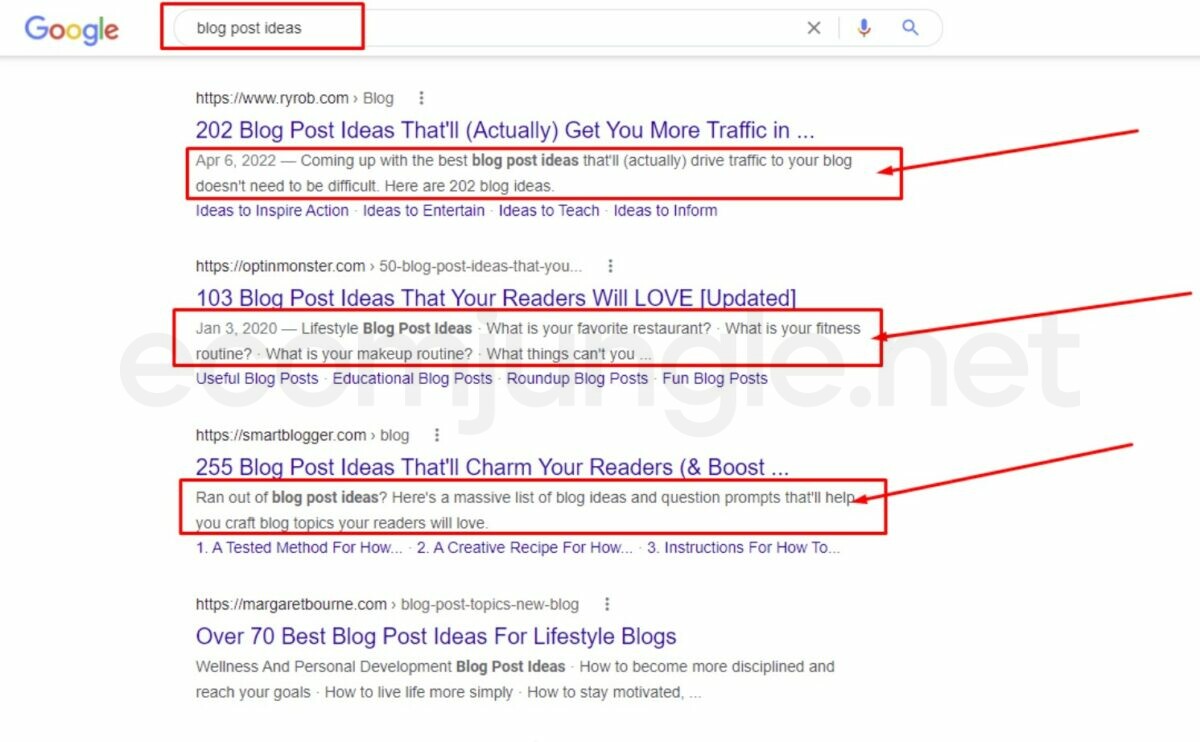
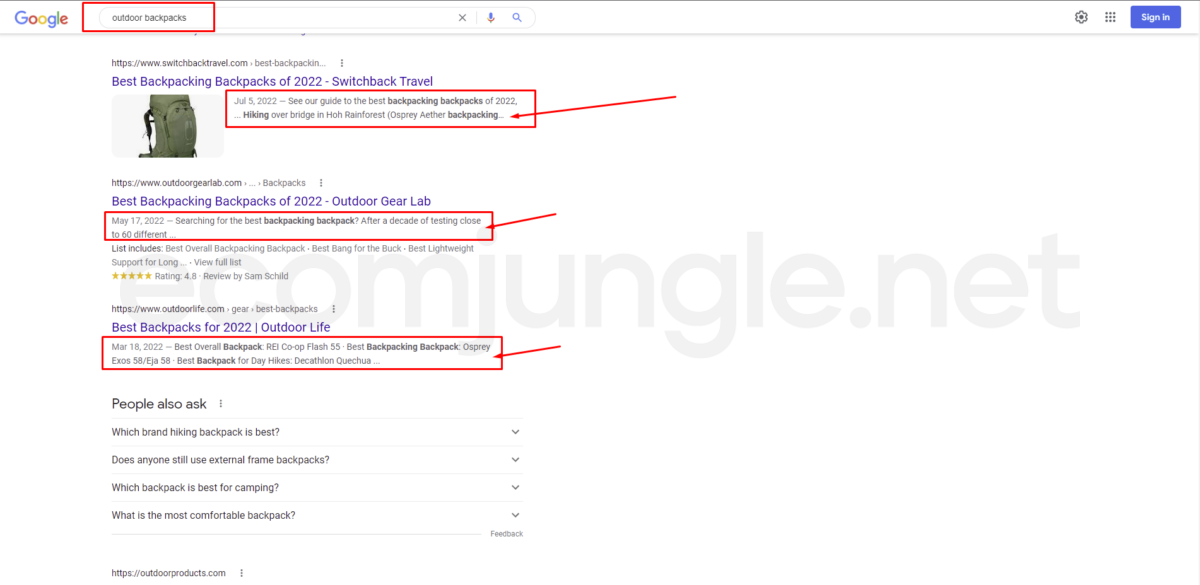
How to do it? In five steps:
- The page must have its meta description describing what is inside.
- It also includes a target keyword related to the page.
- It has between 140 to 160 characters in length.
- Meta descriptions maintain the sentence format.
- Look for emotion and add a call to action.
5. Optimize Images – Including Titles and ALT Attribute
Visual content is fundamental in SEO-friendly writing as it enhances the user experience. In addition, image optimization directly influences the efficiency of your marketing strategies.
Ignoring this step is detrimental to SEO, as it can delay page loading, make it difficult to view content and, consequently, affect search engine rankings.
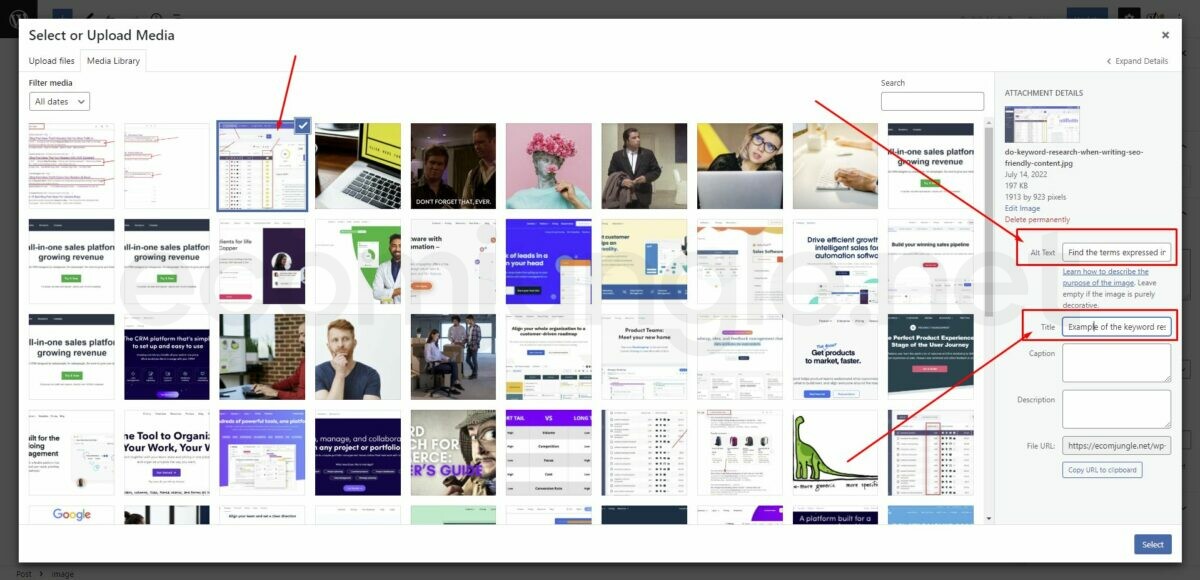
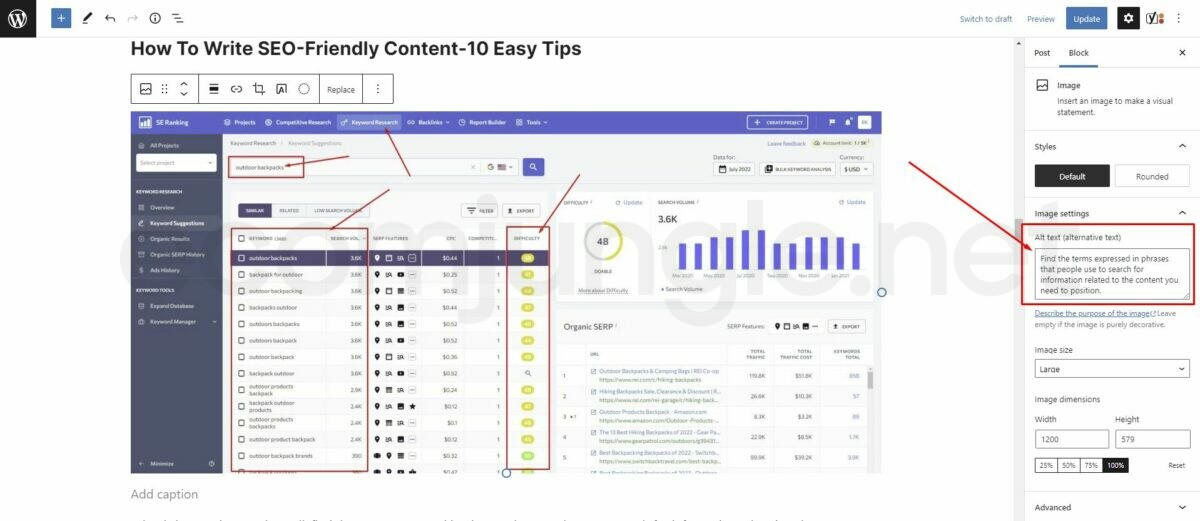
My recommendations:
- Use clear and descriptive file names: Try to put easy file names to the images so that Google Image Search can read them and extract information. For example, “optimize-image-seo.jpeg.”
- Use keywords in the title and alt image tags: The alt attribute refers to an alternative text that allows the browser to understand the image better. For example, it adds information to the file name and title.
Additionally, it is helpful for images when a web browser cannot process them properly.
<img src=”puppy.jpg” alt=”Dalmatian puppy playing with frisbee” />
6. Add Links – Internal Links & External Links
It is important to include internal links, referring your audience to other pages within your domain whose content is directly related to the topic and user search intent.
The presence of internal linking to other articles on your website is a good way for people to find relevant content related to the text in question to keep the user as long as possible on your website!
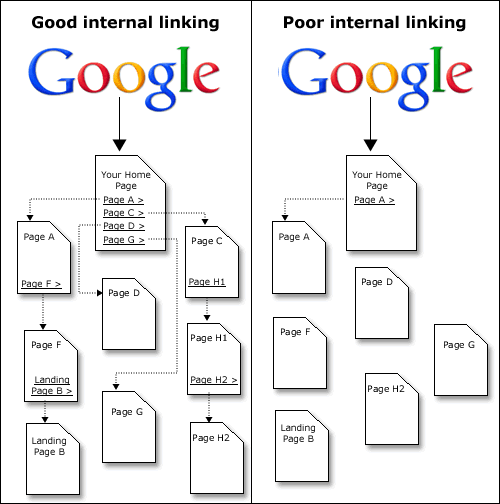
A vital part is the anchor text, which is nothing more than the part of the hyperlink that users click. Mainly, it is one or more words highlighted in color to identify them as a link. When internal linking, I recommend writing the anchor texts using a target keyword that matches the page topic.
External links, also called backlinks or outbound links, are those that vincula two different domains. Being one of the ranking factors of Google, link building strategy is highly beneficial to improve the organic traffic of your page:
- Search engines can index your site easier.
- Users have more chances to find your site and read your blog post.
- They allow the transmission of domain authority or link juice (you acquire more prestige).
In addition, linking to quality external sources, which provide statistical data, gives more credibility to your content.
7. Ideal Content Length: How Long Your Text Needs to Be

I explain that you should use different lengths to achieve other goals in SEO writing:
For example, if you want your SEO-friendly articles to be easy and quick to digest, I recommend a size between 300 to 500 words. These are ideal for creating more superficial content in which you don’t need to go too deep into the subject.
The next step is 1,000 words. This type of content is better valued by search engines, including a little more information on the subject but still being easy to read.
As found in Backlinko’s research the average Google first page result contains 1,447 words.
As long as the information is of high quality and the keywords have been well selected and optimally distributed throughout the article, SEO will do the rest.
Finally, texts of 2,000 words or more are contents that usually have a high level of quality since longer texts favor the introduction of H2 and H3 headings and the placement of keywords, which is an essential factor in SEO positioning.
8. Keep Your Content Updated – Renew Old Blog Posts
You must keep your audience updated and share relevant information regularly, possibly once or twice a week.
You should also update your existing content. For example, if you rewrite a blog post, you are ensuring that your content is up to date with the search engine algorithm and metrics. In addition, you are showing Google that your website is alive and constantly evolving!
If you have doubts, let me tell you that a Backlinko study found that “updating and republishing old articles increases your traffic by 111%.”
My most important tip to keep your content up to date is to focus on the core articles. These articles on your website are most important to you and your online business.
9. Social Media Buttons – Go Viral!
In the course of a post, including social media sharing buttons helps a lot to gain relevance on the web. In addition, if your content is fresh and new, it will encourage users to share the blog post with their friends and contacts.
The content can go viral and reach higher proportions, both about positioning in Google and in terms of dissemination to your audience in an organic and accelerated way.
10. Schema Markup: Highlight the Relevant Content
SEO’s purpose is to attract and generate more quality traffic to your website, and schema markup is a great tool to achieve this.
Schema Markup adds background context to your content. Then, by adding it to specific parts of your website, the search engine can recognize what your content covers.
It will highlight information from your content, make it stand out, and encourage people to visit your website.
Final Thoughts
SEO content creation is an art, but don’t get overwhelmed; follow these simple tips, start by doing keyword research, and select the ones that work best to describe the topic of your page. These are the starting point to creating attractive titles and include optimized elements such as meta description and images that give more visibility to your website and have it between relevant pages.
Remember that practice makes perfect! Therefore, the best way to achieve super attractive SEO-friendly articles is to generate content. Use AI writing tools to start creating content, get inspired, simplify writing, structure your ideas better, and develop content that responds to the current needs of users using their language.
Do you know how to create SEO-friendly content now? Do you have any questions?
Don’t be shy. Share your experience in the comments box!
Frequently Asked Questions
The content of your page is SEO friendly if it has a clean and friendly URL, includes the perfect target keywords, and has optimized meta descriptions and images. It must have attractive titles; the H1-H3 title tag contains the main and related keywords and their variations and uses external and internal linking to give more credibility.
The content of your page is SEO friendly if it has a clean and friendly URL, includes the perfect target keywords, and has optimized meta descriptions and images. It must have attractive titles; the H1-H3 title tag contains the main and related keywords and their variations and uses external and internal linking to give more credibility.
To target your SEO keywords, you must first do keyword research, choose the ones with a high volume and low competition, make a list and categories and answer user search intent. Then, include them in the titles, meta description, image title, and all over the text to send search engines the right signals.